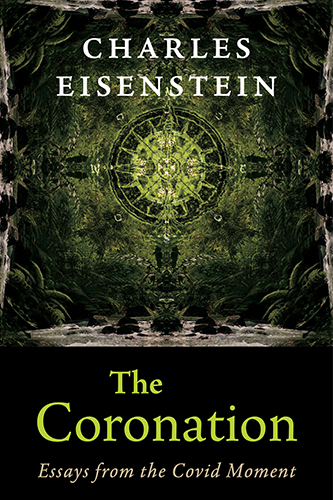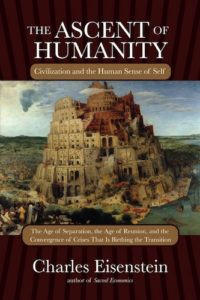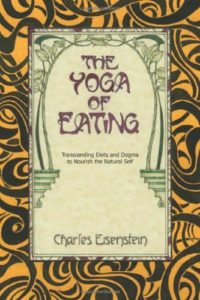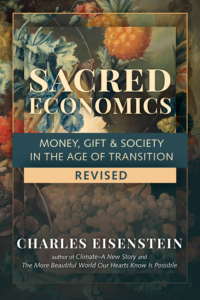The More Beautiful World Our Hearts Know Is Possible
Chapters
Chapter 33: Truth
Ordinarily, it is through no mere act of will that we stand in the Story of Interbeing. It is a long process of healing the wounds of Separation, changing its habits, and discovering unexpected realms of reunion. Sometimes sudden and sometimes gradual, sometimes by hard work and sometimes by grace, sometimes like a birth and sometimes like a death, sometimes painful and sometimes glorious, it is a profound process of metamorphosis. We must keep that in mind as we work as agents of the transition in stories in other people and society generally.
The question “What story shall I stand in?” brings us to an apparent paradox. Part of the “new story” is a kind of meta-awareness of story itself. Are we attempting to enter a new story, or are we attempting to stand outside story altogether? Postmodernists would say that it is impossible ever to stand outside story; as Derrida put it, “There is no such thing as outside-the-text.” They would say that there is no truth or reality outside our social constructions. I don’t agree with this position, though I think at its historical moment it offered a salutary antidote to the pretensions of scientism and rationalism, which purported to offer a royal road to truth. We human beings are meaning-makers, map-makers, exchanging one map for the next and wandering within it as if it were not a map but the territory. Postmodernism liberated us from that trap by questioning whether there even is a territory. A slippery question indeed, given that even the words “there is” are fraught with Cartesian assumptions about the nature of reality; in other words, they themselves are part of a map.
None of this means, however, that there is no territory behind the map. It only means that we cannot use conceptual thinking to get us there. That the world is created from story is itself a story. Each map is a map of another map, layer after layer. We deconstruct each one, expanding our understanding of how it was created and what powers it serves, but no matter how many layers we penetrate, we never get to the territory. That doesn’t mean it isn’t there though. It’s just not to be found in this manner, just as infinity is not to be reached by counting, nor Utopia created by perfecting one more technology, nor Heaven attained by building a tower to the sky. Truth is similarly outside the progression of story from one to the next. That doesn’t mean it is far away; it means it is close, closer than close. The sky starts where the ground ends; we need only look with different eyes to realize we are already there. Utopia is a collective shift of perception away. Abundance is all around us. Only our efforts at tower-building blind us to it, our gaze forever skyward, forever seeking to escape this Earth, this feeling, this moment.
So, while the new story speaks of a place beyond and between stories, it does not bring us to that place. It is a place we need to touch back upon more often than we have, in order to anchor our stories in truth. As long as we are human, we will always create and enact stories. We will form agreements about what things mean, we will mediate those agreements with symbols, and we will embed them in narratives. That is how we coordinate human activity toward a common vision.
The new story allows us room to reconnect with what is prior to story, to draw power from the void that lies prior to meaning, where things just are. A story can carry truth, but it is not truth. The Tao that can be spoken is not the real Tao. “Truth,” wrote Ursula K. Le Guin, “goes in and out of stories, you know. What was once true is true no longer. The water has risen from another spring.” Sometimes we can recognize this truth, but not, as the Scientific Method prescribes, by testing that story’s conformity to experimental results. That attempt draws itself from a story of the world called objectivity, and is always the product of invisible choices (What questions are important to ask? What theory do we test? What authority structures do we invoke to legitimize results?) that also encode a story.
Where, then, do we find the truth? We find it in the body, in the woods, in the water, in the soil. We find it in music, dance, and sometimes in poetry. We find it in a baby’s face, and in the adult’s face behind the mask. We find it in each other’s eyes, when we look. We find it in an embrace, which is, when we feel into it, being to being, an incredibly intimate act. We find it in laughter and sobs, and we find it in the voice behind the spoken word. We find it in fairy tales and myths, and the tales we tell, even if fictional. Sometimes embroidering a tale enlarges it as a vehicle for the truth. We find it in silence and stillness. We find it in pain and loss. We find it in birth and death.
My Christian readers might say, we find it in the Bible. Yes—but not in its literalisms. Truth shines like a backlight through the words. By themselves they are no truer than any other words, and can be (and have been) put into the service of all manner of horrors. Taoism speaks of the “obstacle of the writings”: when we get caught up trying to find truth in the words themselves, rather than traveling through the words to the place whence they arose.
Thus, while we will always live in story, we need to anchor our stories frequently in the truth. To anchor a story in truth prevents us from getting too deeply lost in story, to the point where, as today, children burning alive are “collateral damage,” and the necessities of biological life on Earth are “resources.” These are the kinds of delusions that moments of truth destabilize. Perhaps that is why, according to a Bhutanese monk I met, the king of Bhutan makes sure to spend most of his time in the rural villages. “If I am in the capital too much,” he says, “I cannot make wise decisions.” Surrounded by the artifacts of Separation, we are likely to internalize the story they are part of. Unconsciously, then, we live from that story.
The silence, the stillness, the soil, the water, the body, the eyes, the voice, the song, birth, death, pain, loss. Observe one thing that unifies all the places I listed in which we can find truth: in all of them, what is really happening is that truth is finding us. It comes as a gift. That is what is right about both the Scientific Method and the religious teaching of an absolute truth outside human creation. Both embody humility. This same state of humility is where we can source the truth to anchor our stories.
The necessity to reach beyond story for the truth that anchors story means that there is a limit to how much smart guys in rooms can do to create a more beautiful world. (Am I one of those? Pay no attention to the man behind the curtain!) Much more important are those who make available to us experiences of truth (the senses, the soil, the body, the voice, and so on)—hence the political and ecological necessity for the things we don’t have time for in our rush to save the world.
The truth is beyond our contrivance. That it comes as a gift implies that something has to happen to us in order to initiate us into our full power as changemakers. Our efforts as healers and changemakers evolve as we go through the loss, the breakdown, the pain on a personal level. When one’s own personal subsector of the Story of Separation dissolves, one is able to see that story for the first time for what it is.
Each time that happens (and it can happen as many times as there are variations on the theme of Separation), we enter the sacred space I have mentioned, the space between stories. We might think we can enter it on purpose, without loss or breakdown, perhaps through prayer, meditation, or solitude in nature. Maybe so, but what brought you to such a practice? Unless you were raised in it, something probably happened to eject you from the normal world in which this isn’t something people do.
Besides, one way that spiritual practice works is to bring about the unraveling of old beliefs and self-image—the Story of Self and World. This unraveling is a kind of collapse, a kind of loss, even a kind of death. Whether the journey into the space between stories happens via a practice, a divorce, an illness, or a near-death experience, we are all on the same journey.
Just as our civilization is in a transition between stories, so also are many of us individually. When we look at the various stories we tell ourselves about our lives, certain patterns become apparent, and it may be possible to discern in these patterns two (or possibly more) dominant themes. One might represent the “old story” of one’s life, and the other the “new story.” The first is often associated with various wounds one is born into or has grown into as a member of this culture. The second story represents where one is going, and is consistent with the healing of these wounds.
Here is a process called “What’s true?” that is designed, first, to bring resident stories that lurk invisibly inside us into our field of awareness so as to depotentiate them, and second, through the mantra “What’s true?” to bring the story-bearer into the space between stories, the space where truth is available. The process originated in a retreat I co-led with the marvelous social inventor Bill Kauth in 2010, and has evolved considerably since then. I will present here a fairly original version of it that the reader can adapt to her own teaching and practice.
First, everyone present identifies a situation or choice they are facing, a doubt, an uncertainty—something about which you “don’t know what to think” or “don’t know how to decide.” On a piece of paper, describe the bare facts of the situation, and then write down two separate interpretations of it entitled “Story #1” and “Story #2.” These stories describe what the situation means, the what-ifs around it, what it says about the people involved.
Here is an example of my own. When I finished the first draft of The Ascent of Humanity I began looking for a publisher. Enamored with the beauty and depth of this book that I’d spent so many years writing, it was with high hopes that I sent appropriate pitch packets to various publishers and agents. I’m sure you can guess what happened. Not a single publisher showed the remotest bit of interest. No agent wanted to take it on. How could anyone fail to be seduced by (what I saw as) the profundity of the book’s thesis and the beauty of the excerpts? Well, I had two explanations that inhabited me concurrently, waxing and waning in their relative influence.
Story #1 was as follows: “Face it, Charles, the reason they are rejecting the book is simply that it isn’t very good. Who are you to attempt such an ambitious meta-historical narrative? You don’t have a PhD in any of the fields you write about. You are an amateur, a dilettante. The reason your insights are not in the books you’ve read is that they are too trivial and childish for anyone to bother publishing them. Perhaps you should go back to graduate school, pay your dues, and someday be qualified to make a modest contribution to the civilization that you, in your sophomoric rebelliousness, so conveniently reject. It isn’t our society that is all wrong, it is that you just can’t quite cut it.”
And here was Story #2: “The reason that they are rejecting the book is that it is so original and unique that they do not have a category to put it in, nor even eyes to see it. It is to be expected that a book so deeply challenging to the defining ideology of our civilization would be rejected by the institutions built upon that ideology. Only a generalist, coming from outside any established discipline, could write such a book; your lack of a legitimate place in the power structure of our society is what makes the book possible and, at the same time, what makes quick acceptance so elusive.”
There are several features of these stories worthy of note. First, one cannot distinguish between them on the basis of reason or evidence. Both fit the facts. Second, it is quite obvious that neither story is an emotionally neutral intellectual construct; each is connected not only to an emotional state, but also to a life story and a constellation of beliefs about the world. Third, each story quite naturally gives rise to a different course of action. That is to be expected: stories contain roles, and the stories we tell ourselves about our lives prescribe the roles that we ourselves play.
After each person has written down a situation and two stories about it, everyone assembles into pairs. Each pair has a speaker and a questioner. The speaker describes what he or she has written, ideally taking just a minute or two to do so. It only takes that long to convey the essentials of most stories.
The listener, facing the speaker, then asks, “What’s true?” The speaker responds by speaking whatever feels true in the deep listening attention of the questioner. She might say, “Story #1 is true” or “Story #2 is true,” or she might say, “Actually, I think what is true is this third thing …” or “What’s true is that I wish I could believe Story #2, but I am afraid the first story is true.”
After the response, the questioner follows up with “What else is true?” or, if the answer was just more story, perhaps with “Yes, and what is true?” Other useful questions are “If that is true, what else is true?” and “What’s true right now?” Another way to run the process is simply to repeat the initial question, “What’s true?” again and again.
This is a subtle, unpredictable, and highly intuitive process. The idea is to create a space into which the truth can emerge. It might happen right away, or it might take several minutes. At some point the speaker and the questioner will feel that the truth that wanted to come out has come out, at which point the questioner can say, “Are you complete for now?” The speaker will probably say yes, or perhaps might say, “Actually, there is one more thing …”
Often, the truth that comes out is about the speaker’s true feelings on the matter, or something she knows beyond doubt. When it comes out, there is a feeling of release, sometimes accompanied by a sigh-like exhalation of breath. Leading up to it, the speaker might go through a mini-crisis, an attempt at avoidance through intellectualizing the situation. The questioner’s job is to short-circuit this dissembling and return again and again to “What’s true?” When the hidden truth comes out, it is usually very obvious and often, paradoxically, somewhat surprising as well, something “right in front of my face that I couldn’t see.”
To give you a better flavor for what comes out of this process, here are some examples of truths that I have seen emerge:
“Who am I kidding—I’ve already made my choice! All this rationalization is just my way of giving myself permission.”
“You know, the truth is that I just don’t care anymore. I’ve been telling myself I should care, but honestly, I just don’t.”
“The truth is, I’m just afraid of what people will think.”
“The truth is, I’m using fear of losing my savings as a cover for what I’ve really been afraid of: that I’m wasting my life.”
If the speaker keeps dancing around the truth, the questioner, if he can see it, might make an offering along the lines of “Is it true that …”
The main “technology” in this process is what some people call “holding space.” The truth comes as a gift, welling up through the cracks between our stories. It is not something we can figure out; it comes, rather, in spite of our attempts to figure it out. It is a revelation. To hold space for it might require a lot of patience, even fortitude, as the stories and their attendant emotions seek to draw us in.
Once the truth has come out, there is nothing else to do. The process is finished, and after a moment of silence, speaker and questioner switch roles.
Some processes like these encourage the speaker to make some kind of declaration or commitment based on the truth she has discovered. I advise against it. The truth exercises its own power. After having these realizations, actions that had once seemed inconceivable become matter-of-course; situations that had been hopelessly murky become crystal clear; anguished internal debates fade away by themselves, without any struggle to let go of them. The “What’s true?” process brings something new into the field of attention and therefore into our selves. Indeed, another question lurks behind that of “What’s true?” That other question is “Who am I?”
The same holds for those experiences of nature, death, loss, silence, and so on. The truth they bring changes us, loosens the hold of story. Nothing needs to be done, yet much doing will happen.
I have noticed that life itself conducts a kind of “What’s true?” dialogue with each one of us. Experiences intrude upon whatever story we inhabit, bringing us out of story and back to truth, and inviting us to rediscover parts of ourselves that our story had left out. And life is relentless in its questioning.
What life does to us, we, as part of others’ lives, can do for them, both on a personal level, and on the level of social, spiritual, and political activism. On a personal level, we can decline the frequent invitations we get to partake in the dramas people create that reinforce a story of blame, judgment, resentment, superiority, and so on. A friend calls to complain about her ex. “And then, he had the nerve to just sit in the car waiting for me to trot out and bring him his briefcase.” You are supposed to join in condemnation and affirm the story of “Isn’t he awful and aren’t you good.” Instead you might play “What’s true?” (in disguised form), perhaps simply by naming and giving attention to the feeling. Your friend might be annoyed with you for refusing to join her story; sometimes this will be seen as betrayal, just as any refusal to hate is. In fact you may notice that in leaving a story behind, you may also leave behind the friends that inhabited it with you. This is another reason for the loneliness that is such a defining feature of the space between stories.
The journey out of the old normal into the new has for many of us been a lonely journey. Internal and external voices told us we were crazy, irresponsible, impractical, naive. We were like swimmers struggling through choppy seas, getting only an occasional desperate breath of air enough to allow us to keep swimming. The air is the truth. Now we are alone no longer. We have each other to hold each other up. I certainly didn’t emerge from the self-doubt around my book by dint of some heroic personal effort, courage, or fortitude. I stand in a new story, to the extent that I do, thanks to crucial help at key moments. My friends and allies hold me there when I am weak, as I hold them when I am strong.
Without support, even if you have an experience of universal oneness, once you return back to your life, your job, your marriage, your relationships, these old structures tend to pull you back into conformity with them.
Belief is a social phenomenon. With rare exceptions (such as Frank in “Insanity”), we cannot hold our beliefs without reinforcement from people around us. Beliefs that deviate substantially from the general social consensus are especially hard to maintain, requiring usually some kind of sanctuary such as a cult, in which the deviant belief receives constant affirmation, and interaction with the rest of society is limited. But the same might be said for various spiritual groups, intentional communities, and even conferences like the ones I speak at. They provide a kind of incubator for the fragile, nascent beliefs of the new story to develop. There they can grow a bed of roots to sustain them from the onslaughts of the inclement climate of belief outside.
To discover such an incubator might take time. Someone recently exiting a conventional worldview may feel alone in her rejection of it. New beliefs well up within her, that she recognizes as ancient friends, intuitions from childhood, but without an articulation of those beliefs by someone else, those beliefs cannot stabilize. This again is why it is so important to have preachers to the choir so that she can hear the choir’s loud singing. Sometimes one receives a totally new piece of the Story of Interbeing that no one has articulated yet, for which there is not yet a preacher nor a choir. But even then there are kindred spirits awaiting, more and more of us, as the new story reaches critical mass.
That is happening in our time. True, the institutions built on Separation appear bigger and stronger than ever, but their foundation has crumbled. Fewer and fewer people really believe in the reigning ideologies of our system and their assignation of value, meaning, and importance. Whole organizations adopt policies that, in private, not a single one of their members agrees with. To use a hackneyed analogy, a mere month before the Berlin Wall was dismantled, no serious observer predicted such a thing could happen anytime soon. Look how powerful the Stasi is! But the substructure of people’s perceptions had been long eroding.
And so is ours. I just said the new story is reaching critical mass. But has it reached it? Will it reach it? Perhaps not quite yet. Perhaps it is just at a tipping point, a moment of equipoise. Perhaps it needs just the weight of one more person taking one more step into interbeing to swing the balance. Perhaps that person is you.






